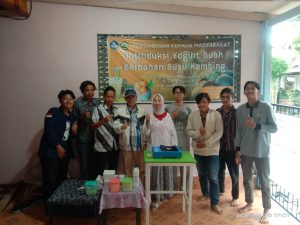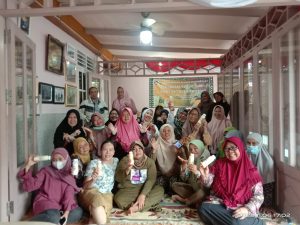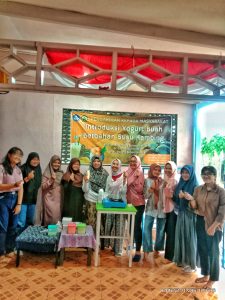Introduction of Fruit Yogurt Made of Goat’s Milk
E. Sulistyowati, I. Badarina, D. Suherman, W. Afrianti and M. E. Malinda
As one of the three tasks of the lecturer (Tri Dharma Perguruan Tinggi), this service is the socialization and application of technology to the community. The Community Service Activity (PPM) funded by the Faculty of Agriculture at the University of Bengkulu will be conducted in October and November 2022. The technology introduced to the community is the manufacture of yogurt made from goat’s milk with pineapple and melon fruit paste.
The basic yogurt ingredient is milk from pasteurized cow’s and goat’s milk. Both kinds of milk are high in nutrition. Dairy cow’s milk contains fat, around 3.81-3.94%, and protein, about 3.59-3.74%. The goat’s milk contains 6.15-6.83% fat and protein 4.48-4.81% protein. Yogurt is a dairy product fermented with microbes. Several microbial starters used in fermenting milk into yogurt are Lactobacillus bulgaricus, Lactobacillus acidophilus, Lactobacillus thermophilus, Bifidobacterium bifidum, Streptococcus thermophilus or some of Sacharomyces cereviseae.
Consuming yogurt has several benefits for human health, including preventing osteoporosis and Alzheimer’s, commonly found in the elderly. In addition, yogurt is useful for maintaining body immunity, especially amid this Covid 19 pandemic. Yogurt also prevents constipation and helps maintain a diet. Yogurt can modify its aroma and taste by adding fruits such as pineapple and melon. In addition, pineapple and melon can be a source of vitamin C. Pineapple contains 47.8 mg of vitamin C and 12 mg of Mg, and 13 mg of Ca/100g of fruit. Melon contains 36.7 mg of vitamin C and 267 mg of K/100g of fruit.
The socialization and introduction of yogurt technology made from goat’s milk began with the pasteurization of goat’s milk (with 15% sugar) at 70ºC for 10 minutes. After that, the temperature was lowered to around 40ºC. Then, a starter of 15% plain yogurt was added, put in a container, and tightly closed. This fermentation process took 18 hours at room temperature. After that, the pineapple (10%) and melon (10%) paste that was made earlier was added, then blended to make it homogeneous. Then it is poured into a bottle or container, tightly closed, and stored in a cooler for consumption.
The organoleptic tests on pineapple and melon yogurts showed that the colors were 2 and 3.8, respectively; flavors 2.7 and 2.6; textures 2,3 and 3,2. It means it tastes rather suitable for colors ranging from yellow-orange, and the texture is a bit soft. As for the hedonic test on general acceptance, it appears that the addition of pineapple and melon is relatively not different, with a score of 2.5 and 2.7, respectively. So, the panelists accept the addition of pineapple and melon to goat’s milk yogurt equally well.



This community service activity was chaired by Prof. Dr. Ir. Endang Sulistyowati, M.Sc., with members of Dr. Irma Badarina, S.Pt., M.P., and Dr. Ir. Dadang Suherman, M.S. This activity took place in RT 12 RW 03, Unib Permai, Muara Bangkahulu, Bengkulu City. The participants were women in this RT (22 people) and several students who researched this topic (2 people) and took Egg and Milk Animal Products Technology course (5 people), and Academic Supervisors students.



